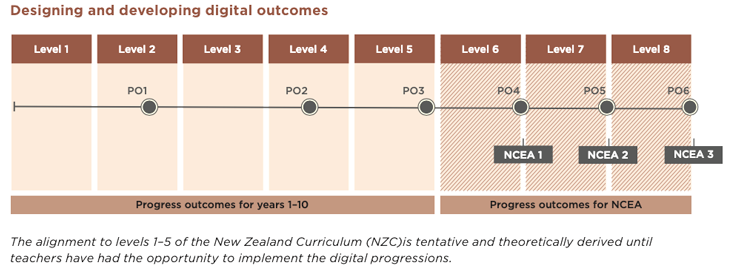Designing and developing digital outcomes: Progress outcomes, exemplars, and snapshots
We are preparing to close this site soon as this content has now moved to Tāhūrangi.
Tāhūrangi is the new online curriculum hub for Te Tāhuhu o te Mātauranga | Ministry of Education.

DDDO: Progress outcome 6
Within authentic contexts, students independently investigate a specialised digital technologies area and propose possible solutions to issues they identify. They work independently or within collaborative, cross-functional teams to apply an iterative development process to plan, design, develop, test and create quality, fit-for-purpose digital outcomes that enable their solutions, synthesising relevant social, ethical and end-user considerations as they develop digital content.
Students integrate in the outcomes they develop specialised knowledge of digital applications and systems from a range of areas, including:
- network architecture
- complex electronics environments and embedded systems
- interrelated computing devices, hardware and applications
- digital information systems
- user experience design
- complex management of digital information
- creative digital media.
Snapshot eleven: Selling cellphone cases
Snapshot twelve: Designing a speaker box
Snapshot thirteen: Farm connections
Snapshot fourteen: Designing a flexible booking system
Snapshot fifteen: Monitoring wildlife

Progress outcomes | Exemplars | Snapshots
The progress outcomes describe the significant learning steps that students take as they develop their expertise in designing and developing digital outcomes.
The diagram above shows the alignment between levels 1–5 of the New Zealand Curriculum and the progress outcomes for designing and developing digital outcomes. The uneven spacing of the progress outcomes reflects the different learning and time required for each outcome and is based on data collected during the development of the digital learning progressions.
Progress outcomes 4–6 set out the learning expected for students engaging in more intensive and specialised digital technologies programmes for NCEA 1, 2, and 3. For this reason, they are directly aligned with levels 6–8 of the curriculum.
- Download the glossary:
Exemplars: Progress outcomes 1–3
The progress outcomes for years 1–10 are illustrated by exemplars that show the breadth of students' expertise at that point on the learning progression.
Each exemplar has four parts: annotation, background to the learning task, the learning task, and the student's response.
The annotation highlights how the student draws on their digital technological knowledge and skills in order to respond to the task.
The student response comprise work samples and/or transcripts of the interactions between the student and the teacher or between the student and their peers.
The exemplars also highlight links to the key competencies and literacy and numeracy.
Snapshots: Progress outcomes 4–6
The progress outcomes that span years 11–13 are illustrated by snapshots that highlight aspects of students' expertise at that point on the learning progression.
The purpose of the snapshots is to illustrate the sophistication of a student's conceptual understanding through insights into their thinking. Each snapshot comprises a brief description of the learning task and a few insights into what the student knows and can do as they work on the task.
The "insights" in the snapshots use the student voice to show their thinking and the sophistication of the actions they take as they apply their understanding to the components of the learning task.
The snapshots are not assessment tasks and they don't fully describe students' responses to the kind of specialist, complex learning tasks that should form a typical digital technologies learning programme in years 11–13.
Find out more
Development paper

In December 2017, the technology learning area was revised to strengthen digital technologies in The New Zealand Curriculum. The goal of this is to ensure all learners have the opportunity to become digitally capable individuals. The paper below describes the development of the revised curriculum content. It includes details on the approach, expertise used (curriculum and subject matter experts), and the research underpinning the revision.
- Download the paper:
 The New Zealand Curriculum Online
The New Zealand Curriculum Online

Read more about the new technology curriculum content here: Digital technologies in The New Zealand Curriculum.
